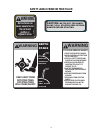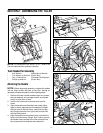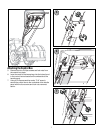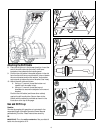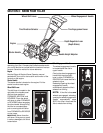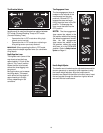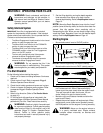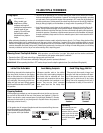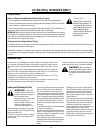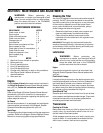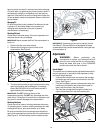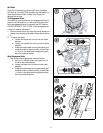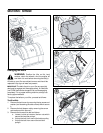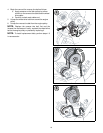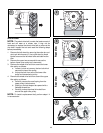
13
Preparing Seedbeds
Tilling wet soil often results in large, hard
clumps of soil that can interfere with plant-
ing. If time permits, wait a day or two after
heavy rains to allow the soil to dry before
tilling. Test soil by squeezing it into a ball. If
it compresses too easily, it is too wet to till.
Avoid Tilling Soggy, Wet Soil
Whenever possible, walk on the untilled
side of the unit to avoid making footprints in
your freshly tilled or cultivated soil. Foot-
prints cause soil compaction that can ham-
per root penetration and contribute to soil
erosion. They can also “plant” unwanted
weed seeds back into the freshly tilled
ground.
While tilling, relax and let the wheels pull the
tiller along while the tines do the digging.
Walk on the side that is not yet finished (to
avoid making footprints in the freshly tilled
soil) and lightly, but securely grip the han-
dlebar with just one hand.
Always operate
the tiller with the throttle in the FAST (rab-
bit) position.
Let the Tiller Do the Work Avoid Making Footprints
• This tiller can be operated in CRT (counter-rotating tine) mode. As the wheels pull forward,
the tines rotate backward. This creates an “uppercut” tine action which digs deeply, uprooting
soil and weeds. Don’t overload the engine when operating in CRT mode, but dig as deeply as
possible on each pass. On later passes, the wheels may tend to spin in the soft dirt. Help them
along by lifting up slightly on the handlebar (or simply switch to operating in FRT mode).
• Avoid the temptation to push down on the handlebar in an attempt to force the tiller to dig
deeper. Doing so takes the weight off the powered wheels, causing them to lose traction.
Without the wheels to hold the tiller back, the tines will attempt to propel the tiller backward,
towards the operator. (Sometimes, slight downward pressure on the handlebar will help get
through a particularly tough section of sod or unbroken ground, but in most cases this won’t
be necessary.)
With experience, you will find the “just right” tilling depth and tine rotation combination
that is best for your garden under specific conditions.
• Operate the tiller in CRT mode when tilling virgin ground, sod or hard soil.
• Operate the tiller in FRT mode when cultivating or tilling soft ground or previously tilled soil.
IMPORTANT:
When operating the tiller in FRT mode, always lower the depth regulator lever (for a shallower tilling depth).
Choosing Correct Tine Depth & Rotation
WARNING: Before
tilling, contact your
telephone or utilities
company and inquire if
underground equipment or
lines are used on your
property. Do not till near
buried electric cables,
telephone lines, pipes or
hoses
.
Tilling Depths
• When cultivating (breaking up surface soil around plants to destroy weeds), adjust the tines to dig only 1" to 2" deep. Using shallow tilling
depths helps prevent injury to plants whose roots often grow close to the surface. If needed, lift up on the handlebar slightly to prevent
the tines from digging too deeply. (Cultivating on a regular basis not only eliminates weeds, it also loosens and aerates the soil for better
moisture absorption and faster plant growth.) Watering the garden area a few days prior to tilling will make tilling easier, as will letting
the newly worked soil set for a day or two before making a final, deep tilling pass.
• When preparing a seedbed, go over the same path twice in the first row, then over-
lap one-half the tiller width on the rest of the passes (see Seedbed 1). When fin-
ished in one direction, make a second pass at a right angle (Seedbed 2). Overlap
each pass for best results (in very hard ground, it may take three or four passes to
thoroughly pulverize the soil.)
• If the garden size will not permit lengthwise and then crosswise tilling, then over-
lap the first passes by one-half a tiller
width, followed by successive passes
at one-quarter width (see Seedbed
3).
With planning, you can
allow enough room
between rows to cultivate.
Leave room for the hood
width, plus enough extra
room for future plant
growth.
Seedbed 3
Cultivating
Seedbed 1 Seedbed 2
TILLING TIPS & TECHNIQUES
1
2
3



